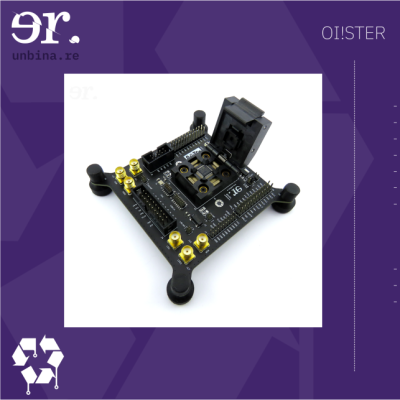Unbinare is a small Belgian company at the forefront of hacking e-waste into something useful, collaborating with recycling and refurbishing companies. Reverse-engineering is a novel way to approach recycling, but it’s arguably one of the most promising ways that we are not trying at scale yet. At Hackaday Remoticon 2021, Maurits Fennis talked about Unbinare’s efforts in the field and presented us with a toolkit he has recently released as a part of his work, as well as described how his background as an artist has given him insights used to formulate foundational principles of Unbinare.
 Unbinare’s tools are designed to work in harmony with each other, a requirement for any productive reverse-engineering effort. OI!STER is a general-purpose salvaged MCU research board, with sockets to adapt to different TQFP chip sizes. This board is Maurits’s experience in reverse-engineering condensed into a universal tool, including a myriad of connectors for different programming/debugging interfaces. We don’t know the board’s full scope, but the pictures show an STM32 chip inside the TQFP socket, abundant everywhere except your online retailer of choice. Apart from all the ways to break out the pins, OI!STER has sockets for power and clock glitching, letting you target these two omnipresent Achilles’ heels with a tool like ChipWhisperer.
Unbinare’s tools are designed to work in harmony with each other, a requirement for any productive reverse-engineering effort. OI!STER is a general-purpose salvaged MCU research board, with sockets to adapt to different TQFP chip sizes. This board is Maurits’s experience in reverse-engineering condensed into a universal tool, including a myriad of connectors for different programming/debugging interfaces. We don’t know the board’s full scope, but the pictures show an STM32 chip inside the TQFP socket, abundant everywhere except your online retailer of choice. Apart from all the ways to break out the pins, OI!STER has sockets for power and clock glitching, letting you target these two omnipresent Achilles’ heels with a tool like ChipWhisperer.
No tool like OI!STER stands alone. The UNBRK is a breakout board for more permanent and tailored reverse-engineering fixtures, with traces and power planes intricately laid out for unparalleled universality for reusing all kinds of ICs. Ad-hoc probing of various signals is still a must even with a purpose-built fixture, and the UNBProbe is a testpoint probe with an optional nifty 3D-printed case, designed with usability and ease of independent assembly in mind. Once you use too many of these probes in one project, you’ll definitely want to build yourself a UNBProbeBase, a mother-board for grouping a bunch of UNBProbes together into one comfortable connector – otherwise, the cables expand to occupy all the space available to them, distracting you from today’s RE puzzle and bothering you with an unsolicited topology exercise.
Whether hacking for the purpose of recycling or simply freeing your devices to do with them what you wish, Unbinare’s tools are equal parts useful and beautiful, and this work extends to other resources like a Wiki page for documenting their efforts and sharing tool designs. If you’d like to keep yourself updated on their next milestones, your best bet would be following them on Twitter for whenever the next tool and project announcements get dropped!















“an STM32 chip inside the TQFP socket, abundant everywhere except your online retailer of choice”
Thanks for the chuckle 😆
Oh man I know right? Makes me anxious to use my blue pill boards because I’ve seen the price they command now (and for a counterfeit cloned MCU no less – I’d be fine paying for a GD32F103 if it were labeled correctly and advertised as such, gigadevices makes good products, I just don’t want to buy something that’s misrepresented)
Seems like some really useful resources. A worthwhile goal though hard to scale, I’m glad someone’s doing it. And I love the naming 😁
I have the motherboard from an older satellite receiver and DVR, was being discarded by family but it’s full of name brand Japanese caps (the satellite company would have to come and fix/replace it if it failed, I think, so the build quality is excellent) so I nabbed it for that. But it pains me to disassemble because it seems like it should be reusable in a more complete fashion, even if I know the Broadcom 7400 (I think) set top box soc and the whole season of the unit is pretty anti-tamper and just e-waste. Wish I could repurpose it as a digital signage driver or thin client or something.
Wish I had read this before placing a digikey order last night, I would have at least looked at the price to build some of these tools from their designs! They look really nice, though with the probes I still see the issue I have tapping into boards: how to keep connections in place?
My best approach so far is using the multi color wire wrap wire spools (has basically all the resistor color code colors), soldering one end (and heat shrink) to rainbow ribbon cable, matching colors, and crimping Dupont style connector pins to the (not split apart) ribbon cable ends. That end can go in a breadboard. I can then strip a little off one end of the wire wrap wire to solder to test points, and use hot glue once the board is fully instrumented to make sure it doesn’t pull traces.
It’s much better than my previous solution, Dupont jumpers to micro grabbers, trying to hold on bits of all black wire wrap wire (I didn’t know they made the multi color rolls when I bought it), taped to cardboard because the wire wrap wire is really too small for my cheap grabbers to hold on to. But it’s still kind of a pain…
I’m not sure these tools ar for sale, at least I didn’t find any link for buying one nor a source file.